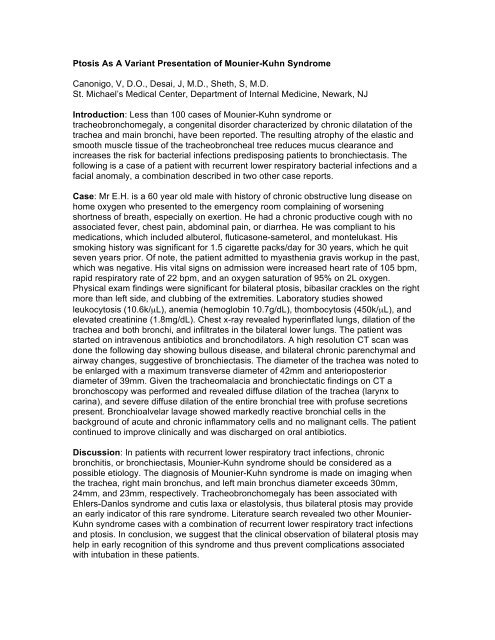Acute Flaccid Paralysis Accompanying West Nile Meningitis Ahmed ...
Acute Flaccid Paralysis Accompanying West Nile Meningitis Ahmed ...
Acute Flaccid Paralysis Accompanying West Nile Meningitis Ahmed ...
Create successful ePaper yourself
Turn your PDF publications into a flip-book with our unique Google optimized e-Paper software.
Ptosis As A Variant Presentation of Mounier-Kuhn Syndrome<br />
Canonigo, V, D.O., Desai, J, M.D., Sheth, S, M.D.<br />
St. Michael’s Medical Center, Department of Internal Medicine, Newark, NJ<br />
Introduction: Less than 100 cases of Mounier-Kuhn syndrome or<br />
tracheobronchomegaly, a congenital disorder characterized by chronic dilatation of the<br />
trachea and main bronchi, have been reported. The resulting atrophy of the elastic and<br />
smooth muscle tissue of the tracheobroncheal tree reduces mucus clearance and<br />
increases the risk for bacterial infections predisposing patients to bronchiectasis. The<br />
following is a case of a patient with recurrent lower respiratory bacterial infections and a<br />
facial anomaly, a combination described in two other case reports.<br />
Case: Mr E.H. is a 60 year old male with history of chronic obstructive lung disease on<br />
home oxygen who presented to the emergency room complaining of worsening<br />
shortness of breath, especially on exertion. He had a chronic productive cough with no<br />
associated fever, chest pain, abdominal pain, or diarrhea. He was compliant to his<br />
medications, which included albuterol, fluticasone-sameterol, and montelukast. His<br />
smoking history was significant for 1.5 cigarette packs/day for 30 years, which he quit<br />
seven years prior. Of note, the patient admitted to myasthenia gravis workup in the past,<br />
which was negative. His vital signs on admission were increased heart rate of 105 bpm,<br />
rapid respiratory rate of 22 bpm, and an oxygen saturation of 95% on 2L oxygen.<br />
Physical exam findings were significant for bilateral ptosis, bibasilar crackles on the right<br />
more than left side, and clubbing of the extremities. Laboratory studies showed<br />
leukocytosis (10.6k/µL), anemia (hemoglobin 10.7g/dL), thombocytosis (450k/µL), and<br />
elevated creatinine (1.8mg/dL). Chest x-ray revealed hyperinflated lungs, dilation of the<br />
trachea and both bronchi, and infiltrates in the bilateral lower lungs. The patient was<br />
started on intravenous antibiotics and bronchodilators. A high resolution CT scan was<br />
done the following day showing bullous disease, and bilateral chronic parenchymal and<br />
airway changes, suggestive of bronchiectasis. The diameter of the trachea was noted to<br />
be enlarged with a maximum transverse diameter of 42mm and anterioposterior<br />
diameter of 39mm. Given the tracheomalacia and bronchiectatic findings on CT a<br />
bronchoscopy was performed and revealed diffuse dilation of the trachea (larynx to<br />
carina), and severe diffuse dilation of the entire bronchial tree with profuse secretions<br />
present. Bronchioalvelar lavage showed markedly reactive bronchial cells in the<br />
background of acute and chronic inflammatory cells and no malignant cells. The patient<br />
continued to improve clinically and was discharged on oral antibiotics.<br />
Discussion: In patients with recurrent lower respiratory tract infections, chronic<br />
bronchitis, or bronchiectasis, Mounier-Kuhn syndrome should be considered as a<br />
possible etiology. The diagnosis of Mounier-Kuhn syndrome is made on imaging when<br />
the trachea, right main bronchus, and left main bronchus diameter exceeds 30mm,<br />
24mm, and 23mm, respectively. Tracheobronchomegaly has been associated with<br />
Ehlers-Danlos syndrome and cutis laxa or elastolysis, thus bilateral ptosis may provide<br />
an early indicator of this rare syndrome. Literature search revealed two other Mounier-<br />
Kuhn syndrome cases with a combination of recurrent lower respiratory tract infections<br />
and ptosis. In conclusion, we suggest that the clinical observation of bilateral ptosis may<br />
help in early recognition of this syndrome and thus prevent complications associated<br />
with intubation in these patients.

















